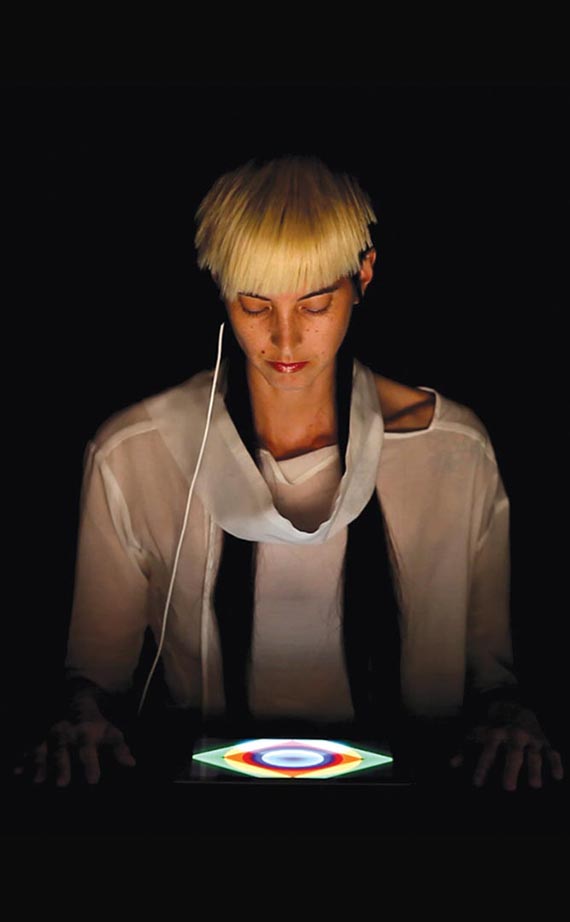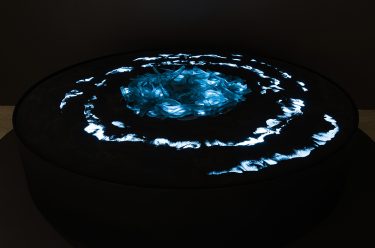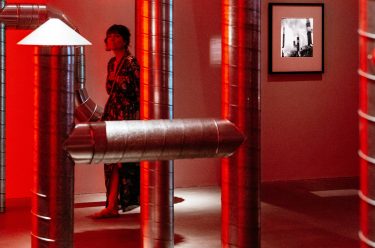
At the recent Born Digital and Cultural Heritage Conference (June 2014), organised by the Play It Again research group, artist George Poonhkin Khut and QAGOMA’S Head of Conservation Amanda Pagliarino presented their perspectives on the Gallery’s acquisition of Distillery: Waveforming 2012, the winning entry in the Queensland Art Gallery’s 2012 National New Media Award.
Distillery: Waveforming is a biofeedback controlled interactive experience conceived as an iOS 5.1.1 application for the third generation Apple iPad. This prototype artwork is an ensemble that presents unique conservation challenges, made up of iPads loaded with a software application called BrightHearts; heart rate monitors; Arduino microcomputers; Apple Mac mini computers; and a WiFi networking system.
The biofeedback aspect of Distillery: Waveforming uses electrical monitoring of the autonomic cardiovascular system. The artwork captures bio-input of a user’s real-time heart rate and this data is then processed via computer and sent on to an iPad as animations and audio. As the user engages with the artwork they can induce changes in the mandala-like animations through subtle changes in their state of relaxation.
Visitors sit down at iPad stations, then don headphones and clip on a heart-rate sensor and begin to see oscillating circular animations on an iPad screen. These animations reflect the visitor’s state of excitement or relaxation. As the visitor reflects on the animations and slows their breathing the animations change from warm colours to cool blues and greens. The sound of the visitor’s pulse, resynthesised through electronic sound design, is fed back as chime-like sounds, producing an immersive, meditative experience.

Distillery: Waveforming is one ‘iteration’ of the biofeedback project begun by George 10 years ago. Since the artwork came into the Collection George has continued to develop BrightHearts with data analysis and processing now imbedded in the app software and the app available for download from iTunes. The BrightHearts app that was acquired as part of Distillery: Waveforming is a developmental version, requiring data analysis to be performed by external computers.
At the conference, George was pleased to have the opportunity to reconnect with Distillery: Waveforming and to see the developmental version of BrightHearts. The superb quality – the richness and depth – that was achieved in the animations is yet to be realised in the downloadable version.

The Gallery places significance on Distillery: Waveforming as a prototype and intends to maintain it in its original configuration for as long as is functionally possible. To enable this, the iPad devices were jail-broken to provide long-term access and management of the BrightHearts app. The Gallery has digitally archived the software to run the various devices; source code, which is the computer instructions interpreted for programming; and supporting video documentation. Two, third-generation iPad devices have been stored as back-up replacement technology.
Audio visual artwork conservators usually find themselves working with electronics and technologies that have in some part been modified, altered, patched, manipulated, rewired, reconfigured, refabricated or completely repurposed. Conserving audio visual artworks requires different conservation approaches and tailored strategies that respond to each individually.
What sets this artwork apart from others is the interest the artist has in its preservation. George has provided the Gallery with invaluable materials for the archive including the source code; copies of all the software programs with descriptions of their modifications and patches; documentary and support material; and a comprehensive user’s manual. Building an archive of this quality with the artist’s assistance provides the Gallery with an extraordinary resource for the future.

